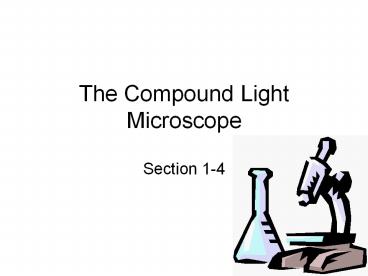The Compound Light Microscope - PowerPoint PPT Presentation
Title:
The Compound Light Microscope
Description:
The Compound Light Microscope Section 1-4 What is a compound light microscope? Mechanism for enlarging an image How Does a Microscope Work? Evolution of the ... – PowerPoint PPT presentation
Number of Views:396
Avg rating:3.0/5.0
Title: The Compound Light Microscope
1
The Compound Light Microscope
- Section 1-4
2
What is a compound light microscope?
- Mechanism for enlarging
- an image
3
How Does a Microscope Work?
the specimen
the image
the eye
Each lens magnifies the image, increasing its
overall size
A lens is a bi-convex disk that bends light
The bent rays produces an image
The farther the light rays are bent, the
larger the image appears
4
Evolution of the microscope
Choice of lens magnification
2 set lenses
5
How Does a Microscope Work?
the specimen
the image
the eye
As the light rays are spread farther apart, the
clarity or resolution of the image decreases
Resolving power A measure of the ability of a
lens or optical system to form separate and
distinct images of two objects with small
angular separation.
Light microscopes are limited in their
magnification by their resolving power!
6
Resolution vs. Magnification
7
How Does a Microscope Work?
the specimen
the image
the eye
The image is always seen upside down and
backwards from its actual position
8
Magnification
- The two lenses are called
- Eyepiece
- Objective
- The eyepiece has a magnification of 10x
- The magnification of the objective lenses vary
and are marked on the lens - Total magnification
- (Eyepiece) X (Objective)
- Example
- 10 X 40
400
9
The Parts of the Microscope and Their Function
Magnification
Maintains proper distance between lenses
Hold objectives- rotates to change magnification
Support body tube
Magnification
Supports slide
Holds slide In place
Focuses image
Regulates amount of light
Sharpens the image
Reflects light towards eyepiece
Supports microscope
10
Proper Procedures
- Carry the microscope with one hand under the base
while grasping the arm with the other hand - Place microscope 5 inches from the edge of the
table - Be careful of the cord when moving around the lab
tables!!
11
Proper Procedures
- 3. Rotate the nosepiece to obtain the proper
objective lens - Make sure the lens clicks into place!!
- 4. Look through the eyepiece and switch on the
lamp - This is your field of view!
12
Proper Procedures
- 5. Place slide on stage, center specimen over
stage - 6. Locate specimen on low power using coarse
adjustment - 7. Carefully switch to medium or high power
- 8. Focus image with fine adjustment
Avoid damaging slide! Do not use course
adjustment with high power!
13
Storing the Microscope
Four steps prepare the microscope for storage
- the 10X objective is in place
- the stage is all the way down
- the power is off
- the cord is wrapped around the base
14
Lets Review!
Eyepiece
Body tube
Nosepiece
Arm
Low power
Medium power
Stage
High power
12.
Course adjustment
Stage clips
Diaphragm
13.
Fine adjustment
Light source
Base
15
Microscope Self Quiz
16
So Lets Review
Lets Review!
Eyepiece
Body tube
Nosepiece
Arm
Low power
Medium power
Stage
High power
Stage clips
Course adjustment
Diaphragm
Fine adjustment
Light source
Base

